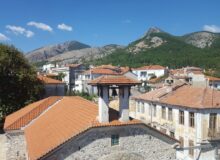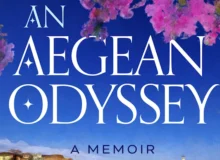Nafplion
The See Greece guide to Nafplion in the Peloponnese, one of the loveliest towns in Greece and close to Tiryns, Mycenae and Epidavros.

Nafplion in the Peloponnese was the Greek capital before Athens and today is a charming waterfront town with good restaurants, museums, shopping, beaches, old fortresses and a delightful atmosphere.
Nafplion (or Nafplio) is one of the most appealing towns in Greece, perhaps even in Europe. It has a lovely waterfront with beaches nearby, a fine headland with wonderful views, several fortresses, some interesting museums, an offshore island to admire, a sophisticated feel to the town with some chic hotels and so many good restaurants that, no matter how long you can manage to stay, you’ll wish you were here for longer.
Much of its charm stems from the medieval architecture of its old town, dating from the second Venetian occupation (1686-1715), not to mention its looming castles and watery vistas. The narrow streets and pristine whitewashed houses of the old town are reminiscent of the Greek islands.
Nafplion is also a convenient base if you want to visit ancient sites including Mycenae and Epidavros, both within a 30-minute drive, and Tiryns, which is only five minutes away.

What to See in Nafplion
Archaeological Museum
The Archaeological Museum of Nafplion offers a captivating journey through the ancient history of Argolis, housed in a stunning Venetian-era building in the heart of Nafplion.
Located in Syntagma Square, the museum occupies a two-storey structure originally built in 1713 during the second Venetian occupation. Since its conversion into a museum in 1926, it has become a cultural landmark showcasing artifacts from the Paleolithic to Roman periods. The museum’s collection highlights the rich archaeological heritage of southern Argolis, with a particular emphasis on Mycenaean civilization.
One of its most remarkable exhibits is the Dendra Panoply, a complete bronze armor set from the 15th century BCE, discovered in a Mycenaean tomb at Dendra. This rare artifact, accompanied by a boar-tusk helmet, offers a glimpse into the martial traditions of ancient warriors.
Visitors can also explore finds from Franchthi Cave, one of the oldest continuously inhabited sites in Greece, along with ceramics, tools, and burial items from various prehistoric and classical periods.
Bourtzi Fortress

The Bourtzi Fortress is a striking sea castle perched on a small islet in Nafplion’s harbor, offering a glimpse into the town’s layered history and Venetian legacy.
Built in 1473 by Italian engineer Antonio Gambello during the first Venetian occupation, Bourtzi—meaning “tower” in Ottoman Turkish—was designed to protect Nafplion’s port from pirate attacks and naval invasions. Its strategic location allowed it to work in tandem with the land-based bastion known as the “Five Brothers,” effectively controlling access to the harbour.

Over the centuries, the Bourtzi served various roles: from a military outpost to a residence for executioners during the Greek War of Independence, and later as a hotel in the mid-20th century. The fortress features three levels connected by movable stairs, with entrances on both the north and south sides. Its compact design and panoramic views make it a popular destination for visitors, accessible by a short boat ride from Nafplion’s port.
Folklore Museum
The Folklore Museum of Nafplion, officially known as the Peloponnesian Folklore Foundation “Vasilios Papantoniou,” is a celebrated cultural institution preserving Greece’s traditional heritage.
Founded in 1974 by costume designer Ioanna Papantoniou in memory of her father, the museum is housed in a beautifully restored 19th-century neoclassical building in Nafplion’s historic center. It gained international recognition in 1981, winning the European Museum of the Year Award for its innovative exhibition on natural textiles in Greece.
The museum’s extensive collection includes traditional costumes, textiles, household items, tools, musical instruments, and photographs that reflect everyday life in the Peloponnese from the 18th to the 20th century. Highlights include intricately embroidered garments, bridal attire, and silver jewellery, showcasing the artistry and symbolism of Greek folk traditions.
Visitors can explore themed exhibits on weaving, dyeing, embroidery, and the role of textiles in marriage customs and dowries. The museum also features temporary exhibitions, educational programs, and a well-curated gift shop offering high-quality local crafts.
Its Kale Fortress
Its Kale, also known as the Acronafplia Fortress, is the oldest fortification in Nafplion, Greece, perched on a rocky peninsula overlooking the Argolic Gulf. The name “Its Kale” comes from the Ottoman Turkish for “inner castle,” reflecting its strategic role during Ottoman rule.
Originally dating back to prehistoric times, the fortress evolved through the Byzantine, Frankish, and Venetian periods, each leaving architectural imprints. Its massive stone walls, some rising over 85 meters, once housed military prisons and offered commanding views of the city and sea. Today, Its Kale is a serene historic site offering panoramic vistas and a glimpse into Nafplion’s layered past
Palamidi Fortress

The Palamidi Fortress is a majestic 18th-century stronghold towering over Nafplion, offering breathtaking views and rich historical intrigue.
Constructed by the Venetians between 1711 and 1714 during their second occupation of the Peloponnese, Palamidi is one of the best-preserved examples of baroque military architecture in Greece. The fortress was built in record time and strategically positioned on a high hill, 216 meters (709 feet) above sea level, to defend against Ottoman advances.
Palamidi has eight bastions, each named after a different figure or saint, and interconnected by a network of walls and stairways. One of its most famous bastions, Miltiades, served as a prison for Theodoros Kolokotronis, a hero of the Greek War of Independence. Visitors can explore the cells, battlements, and panoramic viewpoints that stretch across Nafplion, the Argolic Gulf, and the surrounding countryside. Palamidi is accessible by a scenic drive or a climb up the 999-step staircase from the town below.

War Museum
The War Museum of Nafplion offers a compelling look into Greece’s military history, housed in the country’s first military academy building, originally established by Governor Ioannis Kapodistrias.
Operating as a branch of the War Museum of Athens since 1988, this museum is located in Nafplion’s old town. The building itself is a historical landmark, once serving as the first War Academy of Greece. Inside, visitors encounter a rich collection of artifacts spanning from the Greek War of Independence (1821–1832) to the Balkan Wars, World War II, and other pivotal conflicts.
Exhibits include original weapons, uniforms, medals, flags, and personal items that belonged to soldiers and revolutionaries. The museum also features paintings, photographs, and documents that narrate Greece’s struggle for freedom and sovereignty. A highlight is the display of handmade war flags and the bust of Kapodistrias, symbolizing the nation’s enduring fight for independence.
Ioannis Kapodistrias
Ioannis Kapodistrias (1776–1831) was a distinguished Greek statesman and diplomat who became the first Governor of independent Greece.
Born in Corfu under Venetian rule, Kapodistrias studied medicine, law, and philosophy at the University of Padua. His early political career began in the Septinsular Republic, where he served as Secretary of State. His diplomatic talents led him to the Russian Empire, where he became Foreign Minister under Tsar Alexander I, playing a key role in shaping European affairs, including the reorganization of Switzerland.
Kapodistrias was a fervent supporter of the Greek War of Independence and resigned from Russian service in 1822 to advocate for the Greek cause. In 1827, he was elected as the first Governor of Greece by the Third National Assembly. He arrived in Nafplion in 1828 and began building the foundations of a modern state—establishing schools, reorganizing the military, and centralizing administration.
Despite his reforms, Kapodistrias faced fierce opposition from regional leaders and foreign interests. His authoritarian style and resistance to local autonomy led to political unrest. On September 27, 1831, he was assassinated outside the church of Agios Spiridon, by two villainous chieftains from the Mani region in the southern Peloponnese. You can still see the bulletholes in the wall of the church. Three years later, in 1834, Athens became the new capital of modern Greece.

Shopping in Nafplion
Shopping in Nafplion is a delightful blend of tradition, artistry, and boutique charm, especially in the cobbled streets of the Old Town.
Start by walking along Staikopoulou Street, the heart of Nafplion’s shopping scene, where souvenir shops, artisan boutiques, and local craft stores line the marble-paved walkways. The town is known for its handmade leather sandals, evil-eye jewelry, and locally produced ceramics. Shops like Polytimi Pottery offer exquisite candle-holders and decorative items crafted with creative glazing techniques.
Beyond souvenirs, Nafplion boasts fashion boutiques, art galleries, and specialty food shops selling things like olive oil, honey, and herbal teas. The atmosphere is relaxed and welcoming, with many shopkeepers eager to share the stories behind their products. Hidden alleys reveal treasures like Antiminsio, a gallery and gift shop praised for its curated selection of Greek art and design.




















